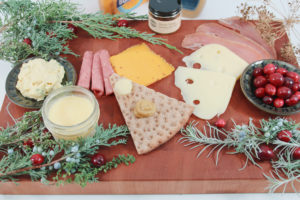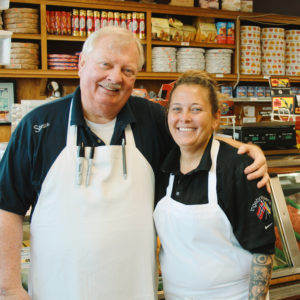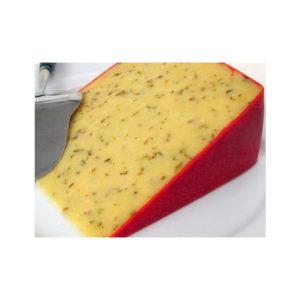
Sandwich boards are a mainstay in Nordic casual entertaining. In the last few years, they have become vogue, and under the label of “charcuterie,” they are now the darling of food magazines, blogs, and cooking shows. So, your grandparents were trendsetters. They just called it “a little lunch.” If you are new to the tradition, it’s simply selecting meats, cheeses, breads, and sides. Arrange attractively and let your guests make their own sandwiches or plates of food.
Some friendly guidance on meat and cheese choices
Steve Dahl can expertly guide you to some classic sandwich board combinations. He grew up with the foods that you see in the meat market case. (Some of the items mentioned below are also available through mail order.)

“You can’t go wrong with Thüringer sausage slices and Jarlsberg cheese for starters,“ he says. Thüringer is a combination of spiced beef and pork that is lightly smoked. Jarlsberg cheese is creamy, mild, and slightly nutty; it complements the Thüringer’s spices and smoke nicely. If you want to build out the cheese selection, Steve suggests Nokkelost. Like Jarlsberg, it’s Norwegian and slightly nutty. However, it has the distinctive taste of caraway, cumin, and cloves. Balance all these flavors with a cheddar. “A white cheddar would be particularly good with the other two. All three go well with crackers or crispbread,” says Steve.
For additional meats, Steve suggests rullepǿlse, a rolled, pressed, then thinly sliced lamb with a rich, distinct flavor, and Göteberg sausage. (I am going to put in a plug for creamy Havarti cheese to complement the lightly smoked Göteberg). Add some slices of Danish rugbrǿd (sourdough rye bread) covered with the Danish Viking Smoke Sea Salt butter for open-face sandwiches. For many years, Kirsten Larsen taught a Danish sandwich class at Ingebretsen’s. Her wise words of advice were to put enough butter on the rugbrǿd that you could see tracks when you passed a serrated knife over the bread.
Add depth with condiments
You can round out the platter with other cold cuts, including any roast turkey or ham from your Christmas dinner. Then go wild with the condiments and dressings. “There’s always Swedish mustard,” says Steve. Ingebretsen’s carries Lar’s Swedish Mustard, the mild and the spicy. What constitutes ‘spicy’? “Really, the main difference is the mild is a fine grind and the spicy is a coarse grind,” he says. People will ask Steve which sausage at the Meat Market is spicy. “I tell them the Swedish sausage. They will say, “I’ve had that. That’s not spicy.” And I say, ‘What do you expect? This is a Scandinavian store!” So don’t worry that the Lars Spicy Mustard will sear your tongue or overwhelm the flavors of the meat and cheese.

The list of possible garnishes and sides is endless and the point of the sandwich board is ease for the host as well as an uncomplicated, enjoyable meal for your guests. Pick and choose a couple of additions, then just enjoy the company of your friends. The Scandinavian classics of pickled beets and potato salad are always good additions. Thoroughly drain then dice the beets so people can easily put a few on their sandwiches. Mashing or using an immersion blender on the potato salad will make it easier to spoon onto crackers or bread. Throw some sprigs of dill on the board, and you are good to go.
The salt you use can make a difference
Update your board with a secret ingredient: Danish Viking Smoked Sea Salt. It adds a complex, intense flavor that can’t be easily pinpointed, but greatly enhances the food it’s seasoning. Then, follow the advice of Steve Dahl, co-owner of Ingebretsen’s and the meat market manager, for what meats and cheeses work well together.
Let’s start with the salt. The name strictly adheres to the principles of truth in advertising. Sea salt is harvested and smoked by a Danish man who lives the lifestyle of the Vikings. Blacksmith Bent Dahlin lives on a remote island with his wife, Bodil Johansson, in the same way their ancestors did a thousand years ago. Bent harvests the trees from their island for smoking the salt. They collect sea water in huge cauldrons and boil it down over a hardwood fire, with the wood giving the smokiness to the salt. The mix of woods includes juniper, which gives a peppery, citrusy edge to the intense smokiness.
Didi Davis, a salt importer and the person with exclusive distribution rights to Danish Viking Smoked Sea Salt is much easier to contact than off-grid Bent, so I asked her to tell me about it. A chef by training and the author of several cookbooks, Didi was in Paris a number of years ago when she first encountered smoked salts. “I thought they were the greatest things ever!,” she says. She liked the seasonings so much that when a business, Salt Traders, came up for sale, she bought it.
Didi relates, “A Danish chef at the Culinary Institute of America first referred Danish Viking Smoked Sea Salt to Salt Traders. He said the husband and wife team who made it were national treasures. They had resurrected a Viking tradition and do the work by hand.” Upon sampling the salt, Didi realized, “It is so well made that it outshines every other smoked salt.”
Add just a little bit at the end
Smoked salts are generally considered “finishing salts,” something that is added to the finished dish for a punch of flavor and crunch. Didi admits that she likes the Danish Viking Smoked Sea Salt on eggs, “That’s so predictable,” she laughs, but she also likes to incorporate the salt into a dish while it’s cooking. Didi suggests using it in vegetarian soups and stews, especially. “A little bit adds perfection,” she says.
Another way to add perfection is to make smoked salt butter and add that to your sandwich board. Spread on crackers or on a slice of rye bread with cold cuts and cheese is a quick trip to a culinary happy place.
Whipped Danish Viking Sea Salt Butter
1/2 cup butter (1 stick) room temperature
2 tablespoons milk
1/2 teaspoon Danish Viking Smoked Sea Salt
Set the butter out of the refrigerator until it is room temperature, and you can easily indent it with your fingers.
Place the butter in a small mixing bowl. Add the milk and salt.
Whip with a handheld electric beater for 5 to 6 minutes, until all the ingredients are incorporated with one another. Start at low and move up to medium speed.
Place the finished butter in a small crock or canning jar.
If you came of age in the 60s, 70s or 80s, eras of competitive entertaining, ask a 20-year-old to supervise your preparations. Instruct him or her to grab your shoulders and yell “Enough!” if this stops being fun for you and you start looking over your shoulder, awaiting the Olympic Sandwich Board Judging Team with their clipboards to arrive. Those of you who are younger and well versed in the culture of casual entertaining, you’ve got this.
Var så god! (Enjoy!)



